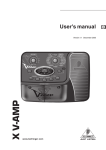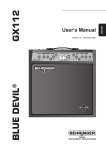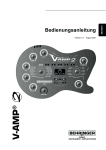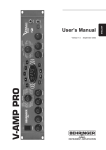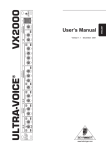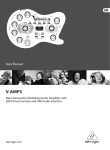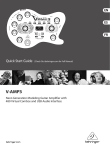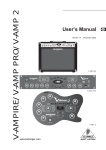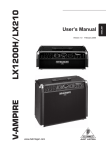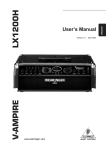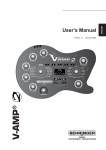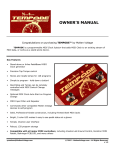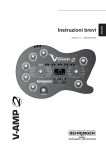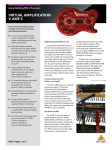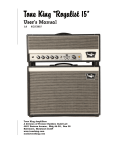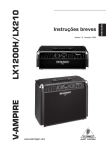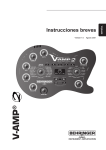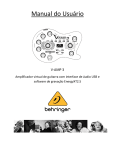Download DATA-MANFULL_V-AMP_ENG_Rev. C.p65
Transcript
V-AMP Version 1.2 May 2001 ENGLISH Users Manual V-AMP SAFETY INSTRUCTIONS CAUTION: To reduce the risk of electrical shock, do not remove the cover (or back). No user serviceable parts inside; refer servicing to qualified personnel. WARNING: To reduce the risk of fire or electrical shock, do not expose this appliance to rain or moisture. This symbol, wherever it appears, alerts you to the presence of uninsulated dangerous voltage inside the enclosure voltage that may be sufficient to constitute a risk of shock. This symbol, wherever it appears, alerts you to important operating and maintenance instructions in the accompanying literature. Read the manual. DETAILED SAFETY INSTRUCTIONS: All the safety and operation instructions should be read before the appliance is operated. Retain Instructions: The safety and operating instructions should be retained for future reference. Heed Warnings: All warnings on the appliance and in the operating instructions should be adhered to. Follow instructions: All operation and user instructions should be followed. Water and Moisture: The appliance should not be used near water (e.g. near a bathtub, washbowl, kitchen sink, laundry tub, in a wet basement, or near a swimming pool etc.). Ventilation: The appliance should be situated so that its location or position does not interfere with its proper ventilaton. For example, the appliance should not be situated on a bed, sofa rug, or similar surface that may block the ventilation openings: or placed in a built-in installation, such as a bookcase or cabinet that may impede the flow of air through the ventilation openings. Heat: The appliance should be situated away from heat sources such as radiators, heat registers, stoves, or other appliances (including amplifiers) that produce heat. Power Source: The appliance should be connected to a power supply only of the type described in the operating instructions or as marked on the appliance. Grounding or Polarization: Precautions should be taken so that the grounding or polarization means of an appliance is not defeated. Power-Cord Protection: Power supply cords should be routed so that they are not likely to be walked on or pinched by items placed upon or against them, paying particular attention to cords and plugs, convenience receptacles and the point where they exit from the appliance. Cleaning: The appliance should be cleaned only as recommended by the manufacturer. Non-use Periods: The power cord of the appliance should be unplugged from the outlet when left unused for a long period of time. Object and Liquid Entry: Care should be taken so that objects do not fall and liquids are not spilled into the enclosure through openings. Damage Requiring Service: The appliance should be serviced by qualified service personnel when: - the power supply cord or the plug has been damaged; or - objects have fallen, or liquid has been spilled into the appliance; or - the appliance has been exposed to rain; or - the appliance does not appear to operate normally or exhibits a marked change in performance; or - the appliance has been dropped, or the enclosure damaged. Servicing: The user should not attempt to service the appliance beyond that which is described in the Operating Instructions. All other servicing should be referred to qualified service personnel. 2 V-AMP Foreword Dear customer, Welcome to the team of BEHRINGER users and thank you very much for expressing your confidence in BEHRINGER products by purchasing the V-AMP. It is one of my most pleasant tasks to write this letter to you, because it is the culmination of many months of hard work delivered by our engineering team to reach a very ambitious goal: To create an out-of-the-ordinary virtual guitar amp that gives you a maximum of flexibility and performance with its modern sound and complete set of functions. The task of designing our new V-AMP certainly meant a great deal of responsibility, which we assumed by focusing on you, the discerning user and musician. It also meant a lot of work and night shifts to accomplish this goal. But it was fun, too. Developing a product usually brings a lot of people together, and what a great feeling it is when everybody who participated in such a project can be proud of what weve achieved. It is our philosophy to share our joy with you, because you are the most important member of the BEHRINGER family. With your highly competent suggestions for new products youve greatly contributed to shaping our company and making it successful. In return, we guarantee you uncompromising quality as well as excellent technical and audio properties at an extremely affordable price. All of this will enable you to fully unfold your creativity without being hampered by budget constraints. We are often asked how we can make it possible to produce such high-grade devices at such unbelievably low prices. The answer is quite simple: its you, our customers! Many satisfied customers mean large sales volumes enabling us to get better conditions of purchase for components, etc. Isnt it only fair to pass this benefit back to you? Because we know that your success is our success too! I would like to thank all people whose help on Project V-AMP has made it all possible. Everybody has made very personal contributions, starting from the designers of the unit (thank you, Volker and Stefan!) via the many staff members in our company (thanks to Thomas for writing the software) to a host of renowned professional guitarists who provide you, the users of BEHRINGER products, with their very personal original artist presets. Finally, we should not forget Oliver who designed and wrote this excellent users manual. My friends, its been worth the trouble! Thank you very much, Uli Behringer 3 V-AMP V-AMP Ultra-flexible virtual guitar amplifier with tube emulator and digital multi-effects processor V-AMP s Authentic virtual guitar preamp with amp/speaker simulation models s Dedicated and independent selectors for amp models, speaker cabinets and digital effects s Revolutionary user interface directly shows all essential preset settings s Amps Selector allows you to directly select popular guitar amp simulations ranging from clean to crunch and tube distortion sounds s Use the Cabinet Function to combine each amp with a matching speaker cabinet s Effects Selector selects first-class effects such as chorus, flanging, phasing, rotary, auto-wah, echo, delay, compressor and various effects combinations s 24-bit stereo multi-effects processor with high-resolution 24-bit AD/DA converters s 125 original artist presets of highest quality, organized in 25 banks for easy editing s Dedicated reverb control adds various reverb types s Wah-wah effect can be controlled manually or via MIDI and is available in addition to any other effect s Authentic 3-band EQ emulation of classic guitar amps s Adjustable aux input for line-level signals (e.g. CD player, drum computer) s Master Volume control and stereo headphones output s Stereo line output with virtual speaker simulation for recording and live applications s Complete MIDI implementation for amp, speaker and effect selection as well as real-time control of all parameters s Built-in auto-chromatic tuner for guitars or electronic instruments s Tap-tempo function for adjusting the speed parameter in specific effects s Built-in professional noise reduction system s Gig bag and footswitch for preset selection and tuner control included s Extremely robust ABS plastic construction ensures long life even under the most demanding conditions s Manufactured under ISO9000 certified management system 4 V-AMP TABLE OF CONTENTS 1. INTRODUCTION .....................................................................................................................6 1.1 The design concept ......................................................................................................................... 1.2 Before you begin ............................................................................................................................. 1.3 Control elements ............................................................................................................................. 1.3.1 User interface ....................................................................................................................... 1.3.2 Connectors on the V-AMP side panel .................................................................................... 1.3.3 Serial number ....................................................................................................................... 6 6 7 7 9 9 2. WIRING EXAMPLES ............................................................................................................. 10 2.1 Standard set-up consisting of guitar, footswitch and external playback source .............................. 10 2.2 Expanded set-up with MIDI foot controller, playback source and mixing console ........................... 10 2.3 Expanded set-up for studio and home recording applications ......................................................... 11 3. AMP/SPEAKER SIMULATION .............................................................................................. 11 3.1 Description of amplifier models ....................................................................................................... 11 3.2 Description of loudspeaker models ................................................................................................ 13 4. EFFECTS PROCESSOR ...................................................................................................... 13 4.1 Description of effects ..................................................................................................................... Reverb and delay algorithms ......................................................................................................... Modulation effects ......................................................................................................................... Combinations of effect algorithms (multi-effects programs) ............................................................ Special effects .............................................................................................................................. 4.2 The separate reverb effect ............................................................................................................. 14 14 14 15 15 15 5. THE V-AMP PRESETS ......................................................................................................... 16 5.1 5.2 5.3 5.4 5.5 Recalling presets .......................................................................................................................... Editing presets .............................................................................................................................. Storing presets .............................................................................................................................. Edit cancel / restoring a single original artist preset ...................................................................... Restoring all original artist presets ................................................................................................ 16 16 17 17 17 6. TUNER .................................................................................................................................. 17 6.1 Tuning a guitar .............................................................................................................................. 17 6.2 Adjusting reference pitch a .......................................................................................................... 17 7. INSTALLATION ..................................................................................................................... 18 7.1 Audio connections ........................................................................................................................ 18 7.2 MIDI connection ............................................................................................................................ 19 7.2.1 Sending/receiving MIDI data ................................................................................................ 19 8. APPENDIX ............................................................................................................................. 20 8.1 MIDI Implementation ..................................................................................................................... 20 9. SPECIFICATIONS ................................................................................................................. 21 10.WARRANTY ........................................................................................................................... 22 CAUTION! + Please note that extreme output volumes can lead to permanent hearing damage. Turn down the VOLUME control before you switch on the unit. Be sure to use appropriate volume levels. 5 V-AMP 1. INTRODUCTION Congratulations! With the V-AMP you purchased a state-of-the-art virtual guitar amplifier that sets new standards in preamp design. When developing the V-AMP our top-priority goal was to achieve the authentic sound of classic amplifiers by means of physical modeling and combine it with latest DSP effects. We accepted the challenge to create a device that will be considered revolutionary for years to come: Your V-AMP is an all-purpose unit that gives you the authentic sound of specific amps and even speaker cabinets without the transportation problems encountered with bulky amp/speaker stacks! Additionally, it provides you with the audio features of state-of-the-art multi-effects processing. In a word: With the V-AMP we present you with a sound tool that offers you anything you need in terms of guitar amplification. BEHRINGER is an audio engineering company that has been successfully developing products for studio and live applications for many years now. Our range of products includes microphones and a variety of 19" devices (compressors, enhancers, gates, tube processors, headphone amps, digital effects devices, DI boxes, etc.) as well as various monitoring and P.A. speakers plus professional live and recording consoles. And weve packed all our technical expertise and know-how into your V-AMP. To top it all, we asked experienced professional guitarists to create original artist presets for you. Just take a look at the separate preset sheet for some inspiration! We also set great store by flexibility, which has become a particularly important factor in the music business over the past few years. Modern guitarists need to offer a broad range of sounds, but should still be able to play in different kinds of applications at short notice: home recording, studio, live concerts. It is this particular circumstance that has rendered huge amplifier stacks somewhat obsolete. With the V-AMP, on the other hand, you have a maximum of features available in such a compact enclosure that you can set up or break down your gear in seconds and have no problems controlling it. Your V-AMP will be state-of-the-art for years to come, because we equipped it with an EPROM that can be updated. In this way, we can keep working on new algorithms and considering your ideas and suggestions. The resulting software updates will be made available for free on the Internet, so as to ensure that your V-AMP will never be outdated. Actions speak louder than words: Nothing will be more convincing than what you feel and hear when youll be testing your V-AMP for the first time. You will experience a virtual next-generation guitar amplifier with astounding features: s Fantastic sound options that outshine anything a conventional guitar amp could offer. s A perfect tube sound emulator that does not suffer from the drawbacks typically found in conventional tube designs (short service life, heat production, mechanical stability). s Latest DSP technology gives you an enormous variety of both classic and modern effect sounds. s A rugged and compact enclosure that allows you to use your V-AMP anytime and anyplace. 1.1 The design concept Weve designed the V-AMP to move ahead the world of digital guitar preamp design. From a technological point of view, your V-AMP is absolutely state-of-the-art and its robust enclosure made of high-grade and extremely durable ABS plastic material will make sure that your V-AMP will withstand even roughest handling on the road. 1.2 Before you begin Your V-AMP was carefully packed in the factory and the packaging is designed to protect the unit from rough handling. Nevertheless, we recommend that you carefully examine the packaging and its contents for any signs of physical damage, which may have occurred during transit. + 6 If the unit is damaged, please do not return it to BEHRINGER, but notify your dealer and the shipping company immediately, otherwise claims for damage or replacement may not be granted. Shipping claims must be made by the consignee. 1. INTRODUCTION V-AMP The mains connection of the V-AMP is made by using the enclosed power supply, which meets all of the international safety certification requirements. As soon as the V-AMP is connected to the mains via its power supply, the unit switches on automatically. + Never connect the V-AMP to the power supply when it has already been connected to the mains! Always connect the V-AMP to its power supply first, then connect the power supply to the mains. The MIDI connections (IN/OUT) are made using standardized DIN connectors. The unit uses an optocoupler for isolated data communications. Further information can be found in chapter 7 INSTALLATION. 1.3 Control elements 1.3.1 User interface Fig. 1.1: User interface control elements 1 + The MASTER control governs the overall volume of your V-AMP. Apart from the AUX LEVEL control , this is the only conventional control on your V-AMP. All other controls are encoder-type rotary controls. 2 VOLUME adjusts the volume level of the preset selected. 3 The BASS control in the EQ section allows you to raise/lower the low-frequency range. 4 Use the MID control to boost or cut the midrange frequencies. 5 The TREBLE control adjusts the high-frequency range of the active preset. 6 The GAIN control determines the degree of distortion. 7 Use the AMPS control to select an amplifier simulation model. The control has a ring of 16 LEDs around it. Each LED corresponds to a specific type of amplifier. 1. INTRODUCTION 7 V-AMP 8 In PLAY mode these five keys select a preset from one specific bank. In SETUP mode (activated by pressing both arrows keys as described in point ) the keys perform the functions indicated on the panel: s A: Activates the MIDI function. Use the arrow keys to select the MIDI transmit and receive channels (1 through 16). s B: Switches the DRIVE function on/off, which audibly raises the degree of distortion. In the signal path the DRIVE function is wired pre-GAIN. + In this mode you can use the EFFECTS MIX control to adjust the wah-wah effect, with the LEDs around the EFFECTS MIX control indicating the pedal position. If no LED is on, the wah-wah effect is disabled. s C: This button activates the CABINET mode. Use the arrow keys to select a speaker type or a combination of several speakers. You can also disable the entire speaker simulation (-). More on this in chapter 3.2 Description of loudspeaker models. s D: Selects the REVERB function. The arrow keys allow you to choose one out of nine reverb types in addition to the effects processor. More on this in chapter 4.2. s E: Here, you can activate the NOISE GATE function. Use the arrow keys to adjust the noise reduction level. When an effect has been selected with the EFFECTS control, its overall level as part of the mix signal can be adjusted with the EFFECTS MIX control. To bypass the effect turn the control to the left until all LEDs are off. 9 + When the EFFECTS control is set to Compressor, the EFFECTS MIX control governs the compressor intensity. 10 The EFFECTS control allows you to select an effect or effects combination. This rotary encoder also has a ring of 16 LEDs around it. Each LED corresponds to one specific type of effect. 11 Use the REVERB control to add the reverb intensity of your choice to the mix signal. To mute the reverb turn the control to the left until all LEDs are off. To fade out the original signal turn the control to the right until the last LED lights up. + The LED rings around the controls VOLUME, BASS, MID, TREBLE, GAIN, EFFECTS MIX and REVERB consist of nine LEDs each. Only one LED or two LEDs next to each other (= intermediate position) will light up to indicate a total of 17 control positions. 12 The TAP button enables you to adapt speed-based effects to the tempo of the music piece played (compressor and auto-wah effects). Additionally, you can use this button to quit SETUP mode or to modify the reference pitch a. Please see chapter 6.2 for further information. 13 The TUNER key activates the tuner or can be used to quit SETUP mode. 14 The two arrow keys select the next bank up or down (BANK DOWN and BANK UP). Keep the keys pressed to skip banks. Press them simultaneously to activate SETUP mode. When SETUP mode is ), the arrow keys can be used for parameter editing. selected and you press one of the keys A E ( 15 The DISPLAY shows the currently selected effect bank and informs you about parameter changes in edit mode. In TUNER mode the DISPLAY reads the pitch of the guitar connected to the V-AMP. 8 1. INTRODUCTION V-AMP 1.3.2 Connectors on the V-AMP side panel Fig. 1.2: Connectors on the V-AMP side panel 16 Connect the stereo phone plug of your footswitch FS112V to the FOOTSWITCH jack on the V-AMP. Now you can select different presets from one bank. If you keep the DOWN button of the footswitch pressed for more than 2 seconds, the tuner is switched on. Use the same button to switch the tuner off again. 17 Your V-AMP features both MIDI inputs and outputs. Here, you can connect a MIDI controller such as our BEHRINGER MIDI FOOT CONTROLLER FCB1010. 18 Connect the enclosed power supply to the POWER SUPPLY connector of your V-AMP. 19 The LINE OUT is on 1/4" TRS connectors and provides the audio signal in stereo, for example, to send it to a recording machine. Depending on the CABINET selected, this output is frequency-corrected (Speaker Emulation). + The LINE OUT works with both balanced and unbalanced 1/4"-jack cables. Use the left line output to route the audio signal to a guitar amp with mono inputs, however, in this case the signal from the multi-effects processor will not be available in stereo. 20 AUX LEVEL controls the volume level of the signal received at the AUX input. 21 The AUX IN (1/4" TRS connector) allows you to feed in additional stereo signals, for example, to play with a drum computer or some sort of playback. 22 The PHONES jack allows you to monitor the V-AMPs audio signal with a pair of commercially available headphones. + 23 If you do not select a specific loudspeaker type when using the headphones, your V-AMP will automatically use a cabinet to improve the sound image over the headphones. Please see table 3.1 for more information about which cabinet is assigned to which amplifier model. You can disable the cabinet simulation by selecting cabinet -. INPUT is the V-AMPs 1/4" jack input for your guitar. Use a commercial 1/4" mono cable. 1.3.3 Serial number The serial number is printed on the rear panel of your V-AMP. Please take the time to fill out and return the warranty card within 14 days after the date of purchase, so as to be entitled to benefit from our extended warranty. Or use our online registration option available on the Internet at www.behringer.com. 1. INTRODUCTION 9 V-AMP 2. WIRING EXAMPLES 2.1 Standard set-up consisting of guitar, footswitch and external playback source To use your V-AMP for rehearsals, please wire up the unit as shown in fig. 2.1. Of course, you can also use a drum computer instead of the playback source (tape deck, etc.). Use the PHONES jack to connect a pair of headphones. The enclosed footswitch FS112V allows you to select five presets from one bank or activate the tuner. Fig. 2.1: Standard set-up 2.2 Expanded set-up with MIDI foot controller, playback source and mixing console For more sophisticated applications, e.g. on stage or for rehearsals with a band, you should try this wiring configuration. Of course, this expanded configuration builds on the standard set-up described in chapter 2.1. Use the MIDI foot controller to change presets, banks and amp models, or the tuner. The LINE OUT signal can be fed into a P.A. or recording console, and the AUX input can be used to play back an additional stereo signal. Fig. 2.2: Expanded set-up 10 2. WIRING EXAMPLES V-AMP 2.3 Expanded set-up for studio and home recording applications As a matter of fact, your V-AMP will be a perfect tool to record your guitar parts on tape or digital recorders. The advantage is clear: Your V-AMP gives you utmost flexibility, as you can set it up in the control room of the studio and dont need any loudspeaker, i.e. you have perfect control over your sound. Whenever you feel that the guitar sound coming out of the recording console needs improvement, you can tell the audio engineer and work with him to adjust the sound that fits into the recording. In a word: There is no need for bothersome commuting between the recording and control room. Fig. 2.3: Expanded set-up for studio and home recording applications 3. AMP/SPEAKER SIMULATION This is an absolute highlight of your V-AMP: The simulation models can make your home recording work much easier, because you dont need to mike your guitar amp. The V-AMP allows you to choose from one of those legendary guitar amps, whether you play Brit Pop, Blues or Heavy Metal. Additionally, you can tailor each amp and its sound to suit your personal ideals and connect it to one of 15 speaker cabinets. And to top it all, your virtual amp even comes with a digital effect and reverb type. More on this in chapter 5 V-AMP PRESETS. After power-up the V-AMP automatically loads the last preset selected. The LED ring around the AMPS control shows which amp type has been selected. Simply turn the control to select another amp model. Then, use the VOLUME, BASS, MID, TREBLE and GAIN controls to modify the basic sound. Typically, you will first select an amplifier model, followed by a specific cabinet and effect. Chapter 5 describes how to store your settings. To get a clear overview of all amp simulations available, please read the following section that describes the various amplifier models implemented in your V-AMP. 3.1 Description of amplifier models AMERICAN BLUES: This amp has been modeled on a Fender Bassman 4 x 10 Combo. Originally designed as a bass amp, the Fender Bassman soon became the standard amp of blues giants such as Steve Ray Vaughan or Billy Gibbons, because of its unique distortion sound. As you would expect, it has lots of power in the bass range but is still quite flexible in the mid and treble ranges. MODERN CLASS A: This amplifier is characterized by its moderate distortion and almost hi-fi sound. It is modeled on the Matchless Chieftain, a very expensive, hand-made amp. TWEED COMBO: This was Jeff Becks favorite sound when he recorded Blow by Blow and Wired. Actually, the Tweed Combo was not designed as a heavy-distortion amp, but with its small power stage it is ideally suited to produce merciless overdrive sounds. 3. AMP/SPEAKER SIMULATION 11 V-AMP CLASSIC CLEAN: In the 80s this was the preferred sound of Buzzy Feiten (guitarist with the Dave Weckl Band). The sound of this transistor amp is characterized mainly by its brilliance that makes it cut through the mix. It is particularly suitable for the New Wave sound of the 80s which is celebrating its renaissance today. It should not be forgotten that the JC-120 was extremely popular among players of Fender Rhodes pianos. BRIT BLUES: Modeled on the JTM 45 the first Marshall amp there is! By the way, this was Eric Claptons favorite amp when he performed with The Cream. And it was the JTM 45 on which many later Marshall amps with their powerful sound were based. Extreme gain settings produce a highly compressed and dirty distortion sound. In combination with the 2 x 12" speaker simulation model you can create impressive Bluesbreaker sounds. BRIT CLASS A: This model is based on the Vox AC 30, which was originally designed in the 60s when guitarists wanted amps with improved brilliance in sound, a feature the makers of Vox amps implemented successfully by means of revolutionary bass and treble controls. Brian May and The Edge are probably the best known users of Vox-type sounds. BRIT CLASSIC: After focussing intensively on a 59 Marshall Plexi 100 Watts, we have shaped this amp model which is a hit for clean sounds. The original amp was played by Jimi Hendrix, Eric Clapton and Jeff Beck. BRIT HI GAIN: Compare this model to a Marshall JCM 800. Although the original is known mostly for its distorted sounds, it also produces a charming sound with low gain settings, for example, to play in the style of Steve Ray Vaughan or Michael Landau. In distortion mode it sounds like Gary Moore in his early days, but of course you can also use it for Heavy Metal. RECTIFIED HI GAIN: We took a Mesa Boogie Dual Rectifier Trem-O-Verb from 1994 as shining example for this amp model. It produces a modern, high-gain sound that makes itself heard in any group setting. The tone control is post-gain, which allows you to tailor distorted sounds down to the last detail. Its a great amp for Heavy Metal, but also for Steve Lukather-like sounds. The best known user of this amp is John Petrucci, guitarist with Dream Theater. MODERN HI GAIN: Here, too, the tone control is post-gain making extremely distorted sounds cut through the mix. The sound of MODERN HI GAIN is ideally suitable for Grunge guitarists, but is also used by performers such as Steve Vai and Joe Satriani. Steve Lukather, Nuno Bettencourt, Steve Vai and others have made the Soldano sound popular. When playing a Gibson Les Paul, MODERN HI GAIN sounds best when you turn down the volume control on the guitar a bit. FUZZ BOX: This sound has no equivalent in amp history, but is based on a special fuzz box. Jimi Hendrix was one of the first guitarists to use this legendary broadband transistor distortion. The humming distortion sound produced by the FUZZ BOX has become popular again with Alternative Rock and Grunge music. ULTIMATE V-AMP: This is brute force add some DRIVE to make this high-gain sound even more powerful. The ULTIMATE V-AMP is basically a rectifier amp that has been souped up a bit. DRIVE V-AMP: This model is based on a modern high-gain lead amp producing a soft, yet precise sound with plenty of drive, so its ideal for lead guitar work. The DRIVE V-AMP is modeled on the Mesa Boogie Mark III. CRUNCH V-AMP: Use this amp to play modern blues or jazz music. Its sound is what you would call crunchy not clean, but not too front-stage either. CLEAN V-AMP: With this amp we managed to simulate a Roland JC-120. The result? The brilliance of a transistor amp combined with the power that is usually associated with an undistorted tube amp. TUBE PREAMP: Quite early in guitar amp history, audio engineers realized that tube sounds have a very special charm. They used tube amps to give sound sources of all kinds more warmth. With this amp model you can not only refine guitar sounds. Try sending a vocal track through the V-AMP and give it the finishing touch with the TUBE PREAMP algorithm (apart from that, its a perfect tool to breathe new life into your guitar as well). Fenderä, Voxä, Marshallä, Mesa Boogieä, Gibsonä, Soldanoä, Matchlessä and the names of musicians and music groups are registered trademarks of their respective owners, with no connection whatsoever to BEHRINGER company. 12 3. AMP/SPEAKER SIMULATION V-AMP 3.2 Description of loudspeaker models The sound of any guitar combo amp depends largely on the speaker(s) to which it is connected. In the past 50 years, lots of experiments have been carried out, so as to find out which speaker type is the best match for a specific guitar sound and how the sound is modified if a specific speaker is combined with others. The character of a loudspeaker depends on its power rating, impedance, sound pressure level and size, and not least on the material it is made of. 8", 10" and 12" speakers have been found the best sizes for electric guitar amplification. Please see the list of V-AMP speaker cabinets below and how they match the various amp simulation models: No. 1 2 3 4 5 6 7 8 9 10 11 12 13 14 15 Cabinets Configuration BYPASS (NO SPEAKER-SIMULATION) 1 x 8" VINTAGE TWEED 4 x 10" VINTAGE BASS 4 x 10" V-AMP CUSTOM 1 x 12" MID COMBO 1 x 12" BLACKFACE 1 x 12" BRIT ’60 1 x 12" DELUXE ’52 2 x 12" TWIN COMBO 2 x 12" US CLASS A 2 x 12" V-AMP CUSTOM 2 x 12" BRIT ’67 4 x 12" VINTAGE 30 4 x 12" STANDARD ’78 4 x 12" OFF AXIS 4 x 12" V-AMP CUSTOM In combination with Amp ... No. Name 1 AMERICAN BLUES 2 MODERN CLASS A 3 TWEED COMBO 4 CLASSIC CLEAN 5 BRIT BLUES 6 BRIT CLASS A 7 BRIT CLASSIC 8 BRIT HI GAIN 9 RECTIFIED HI GAIN 10 MODERN HI GAIN 11 FUZZ BOX 12 ULTIMATE V-AMP 13 DRIVE V-AMP 14 CRUNCH V-AMP 15 CLEAN V-AMP 16 TUBE PREAMP ... we recommend Cabinet ... No. Name 2 4 x 10" VINTAGE BASS 9 2 x 12" US CLASS A 1 1 x 8" VINTAGE TWEED 8 2 x 12" TWIN COMBO 12 4 x 12" VINTAGE 30 11 2 x 12" BRIT ’67 12 4 x 12" VINTAGE 30 12 4 x 12" VINTAGE 30 12 4 x 12" VINTAGE 30 12 4 x 12" VINTAGE 30 14 4 x 12" OFF AXIS 15 4 x 12" V-AMP CUSTOM 15 4 x 12" V-AMP CUSTOM 15 4 x 12" V-AMP CUSTOM 15 4 x 12" V-AMP CUSTOM - Tab. 3.1: V-AMP cabinets and amp/cabinet interaction 4. EFFECTS PROCESSOR A very special feature of your V-AMP is its built-in multi-effects processor module, which offers 16 different groups of first-class effects such as chorus, flanging, delay, auto-wah as well as various effects combinations. The MIDI functions allow you to use an additional wah-wah effect, which can be controlled best from a MIDI foot controller equipped with an expression pedal such as our BEHRINGER FCB1010. More on this in chapter 8.1 MIDI implementation. + The multi-effects processor is basically in stereo, so that you can use stereo effects when recording via the LINE OUT, or play in stereo using a second amplifier. Use the TAP button and EFFECTS MIX control to edit the V-AMP effects: 4. EFFECTS PROCESSOR 13 Effect No. V-AMP Effect EFFECTS MIX Control TAP Button 1 2 3 4 5 6 7 8 9 10 11 12 13 14 15 16 ECHO DELAY PING PONG PHASER/DELAY FLANGER/DELAY 1 FLANGER/DELAY 2 CHORUS/DELAY 1 CHORUS/DELAY 2 CHORUS/COMPRESSOR COMPRESSOR AUTO WAH PHASER CHORUS FLANGER TREMOLO ROTARY Mix Mix Mix Delay Mix Delay Mix Delay Mix Delay Mix Delay Mix Chorus Mix Ratio Depth Feedback Mix Feedback Mix Mix Delay Time Delay Time Delay Time Delay Time Delay Time Delay Time Delay Time Delay Time Modulation Speed Modulation Speed Modulation Speed Modulation Speed Modulation Speed Modulation Speed Tab. 4.1: V-AMP effects 4.1 Description of effects The following section includes a short description of each effect that can be created with the multi-effects processor of your V-AMP. Reverb and delay algorithms REVERB: Reverb is still the most important effect for mix-downs or live playing, and we at BEHRINGER set great store by giving you as much as nine different reverb programs, so that you can use the most appropriate reverb program for each specific application. The reverb effect can be added independently of all the other effects (see chapter 4.2). ECHO: Echo, i.e. delayed repetitions of the input signal, is quite similar to the stereo delay effect, except for the fact that the high-frequency content of the repeated signals is decreasing, which simulates a vintage tape delay used in the pre-digital era. The reflections are routed by turns to the left and right channel producing a quasi-stereo effect. DELAY: This algorithm delays the input signal, with different tempo settings producing interesting effects. Especially U2s The Edge has demonstrated the potential of this effect. PING PONG: A delay effect that changes its position on the stereo basis. Modulation effects PHASER: Phasing widens the sound making your guitar sound thicker and richer. From a technical point of view, phasing is a modulation effect that produces a multi-stage phase shift between the direct and effect signals. As the frequency-dependent phase shift is modulated, the various frequency ranges of the signal are raised or lowered in their amplitudes. Depending on the setting you choose, the resulting phasing effect is either slightly modulating in character or produces heavy sound coloration. FLANGER: Flanging is a constant up/down modulation of the signal pitch. CHORUS: This effect resembles the flanging effect, however, has no feedback parameter. It produces a detune effect that is very pleasant in character and is therefore best suited to make your guitar sound richer. 14 4. EFFECTS PROCESSOR V-AMP Combinations of effect algorithms (multi-effects programs) PHASER & DELAY: Phasing and delay combined in one algorithm. FLANGER & DELAY: Here, the input signal is delayed and processed with a pronounced wave effect. Use this effect to highlight single notes or to make solo lines sound more interesting. CHORUS & DELAY: This algorithm combines a delay with the all-popular chorus effect. CHORUS & COMP: A compressor creates astounding effects, in particular, with sustaining guitar notes. In combination with a chorus, the audio signal becomes much more dense in character. Special effects COMPRESSOR: A compressor limits the dynamic range of audio material thus creating audible and creative effects. Heavy compressing (EFFECTS MIX control) allows you to work on the overall dynamic range of the program material. AUTO WAH: The wah-wah effect became legendary with Jimi Hendrix. Describing it is much more difficult than listening to Hendrix Voodoo Chile. In American funk music from the 70s you will also hear auto-wah effects used in a variety of applications. TREMOLO: Simulates the classic Fender tremolo. Its popularity has been renewed with trip hop music. ROTARY: This is the quintessential simulation of the classic organ effect normally produced by speakers that rotate at slow/fast speed in a bulky and extremely heavy speaker cabinet. This effect uses the physical principle known as Doppler effect to modulate the input signal. NOISE GATE: Noise gates are used to remove or reduce noise or other interference signals. Guitar signals are particularly sensitive to interference, because guitarists use high gain settings and the pick-ups of the guitar can amplify unwanted interference, which becomes audible especially during music pauses. A noise gate simply mutes the signal during pauses, thus eliminating the interference as well. 4.2 The separate reverb effect Reverb No. The reverb effect produced by your V-AMP is independent of the built-in multi-effects processor and can be added freely to the mix signal. Simply activate the REVERB function by pressing the D button in SETUP mode, and use the reverb keys to choose a reverb type from a total of nine different algorithms: Reverb Type Quality 0 1 2 3 Tiny Room Small Room Medium Room Large Room Classic room simulation featuring various room sizes from bathroom to cathedral. 4 Ultra Room Special effect transforming guitar signals into heavenly pad sounds. 5 6 7 8 Small Spring Medium Spring Short Ambience Long Ambience Simulations of typical spring reverbs. Simulates the early reflections of a reverbless room. Tab. 4.2: The various reverb effects implemented in the V-AMP 4. EFFECTS PROCESSOR 15 V-AMP 5. THE V-AMP PRESETS Your V-AMP stores 125 editable preset, organized in 25 banks, i.e. each bank holds 5 presets. Each preset is composed of up to five ingredients: s an amp simulation model, s the basic sound of that amp (depends on the position of controls s your preset edits in SETUP mode (DRIVE function, speaker simulation, reverb, noise gate), s an effect of your choice, and s the wah-wah effect (via MIDI control only). to ), Please find a list of all presets enclosed with the V-AMP users manual. 5.1 Recalling presets After power-up the V-AMP automatically loads the last preset selected. In the following example, its preset D from bank 23: Fig. 5.1: Recalling presets In this case, you can recall another preset from the same bank by pressing buttons A, B, C or E. The two arrow keys (BANK UP and BANK DOWN) allow you to switch to another bank. The display always indicates the bank selected. Once a new bank has been selected, the preset will be changed only when you press one of the buttons A - E. The button LEDs inform you which preset is selected from the current bank. 5.2 Editing presets Editing presets is easy and can be done quickly. Right after selecting a preset you can start editing it. It will probably be most useful to select an amp model first by turning the AMPS encoder. The LED of the preset button (e.g. D) starts flashing and signals that edits are being made. Now, change the settings of the controls VOLUME, BASS, MID, TREBLE and GAIN to your choice. When you use the EFFECTS encoder to select an effect, the EFFECTS MIX control allows you to adjust its intensity as part of the mix signal. Then, press the arrow keys simultaneously to enter SETUP mode. Use the buttons B - E to activate the functions DRIVE, CABINET, REVERB and NOISE GATE. When you edit these functions with the arrow keys, the display reads the value of the currently selected parameter. Press the TAP or TUNER button to quit SETUP mode and return to PLAY mode. + 16 Except for the compressor and auto-wah algorithms, the parameters of all internal effects are speed-based. Lets assume that you wish to adapt the effect to the tempo of the playback: Simply hit the TAP button twice in the rhythm of the music; now the effect tempo follows the tempo of the music program. 5. THE V-AMP PRESETS V-AMP 5.3 Storing presets To save your edits keep the preset button of your choice pressed for about 2 seconds, thus overwriting the previous settings (button LED lights up permanently). + 5.4 Of course, you dont have to save your edits in the same memory location as the original preset. To select a different memory location use the arrow keys (BANK UP and BANK DOWN) to recall a preset bank. Then, press the preset button of your choice for about 2 seconds to store your settings. In this way, you can edit a preset originally stored in, for example, bank 5 and memory location D, to e.g. bank 6, preset A. Edit cancel / restoring a single original artist preset When you have edited a preset and find that you dont like what youve changed, you can cancel your edits. We assume that you have selected and edited preset C (button LED flashes), but wish to recall the original settings: Simply select another preset; now, when you recall the previously edited preset (here: C), all edits have been canceled. However, when you keep both arrow keys pressed after editing until the display reads Pr, you can recall the original artist preset originally stored in the selected memory location. Dont forget to store this preset by pressing the preset button for about 2 seconds. 5.5 Restoring all original artist presets Do as follows to restore all factory presets: Keep the buttons D and E pressed, before you switch on your V-AMP. After power-up the display reads CL. Release the two keys and press both arrow keys to overwrite all user-edited presets and replace them by the original artist presets. 6. TUNER Press the TUNER button to activate the built-in tuner. 6.1 Tuning a guitar The chromatic tuner automatically detects the frequency of all basic guitar notes, for example, A string = 440 Hz. When you connect your guitar to the V-AMP and play an open string, the tuner tries to detect and display the note. Since the tuner uses a chromatic scale, it also detects semi-tones, which are preceded by a b in the display. It may happen though that a note displayed as, for example, a is slightly out of tune, which is shown by at least one of the four arrow LEDs at the bottom edge of the display lighting up. Sometimes, even two LEDs may light up, which indicates that the pitch of the tone currently played is just in between the pitches represented by the two single LEDs. When the circular tuner LED in the middle lights up, the tone played is in tune. 6.2 Adjusting reference pitch a To give you maximum freedom when tuning your guitar, you can change the preset reference pitch a. Just to make things clear, lets discuss this in some more detail. The so-called concert pitch a has been raised repeatedly over time: For example, the tuning forks used by Bach, Handel or Mozart were tuned to 415, 420 or 421 Hz respectively (oscillations per second). Today, orchestras tune to a = 444 Hz, and the Berlin Philharmonic Orchestra tries to lead the pack by using a concert pitch of 447 Hz. The reference pitch a in your V-AMP is set to 440 Hz. If you wish to play with a big orchestra who tune their instruments to 444 Hz, you will need a function that allows you to change the reference pitch a of your V-AMP. Activate this function as follows: In PLAY mode, activate the tuner by pressing the TUNER button, then press both arrow keys to enter SETUP mode. The display reads 40, which corresponds to 440 Hz. Use the arrow keys to raise or lower the reference pitch by up to 15 Hz. The display only reads the two last figures of the basic tone, because the first figure is always 4. For example, when you start with a reference pitch of 6. TUNER 17 V-AMP 440 Hz and press the right arrow key three times, the display reads 43, i.e. 443 Hz. Quit SETUP mode by pressing the TUNER or TAP button. Any changes will be stored automatically. The reference tones for the remaining strings on your guitar will be adjusted automatically to the new reference pitch. 7. INSTALLATION 7.1 Audio connections The input of your BEHRINGER V-AMP is on a mono 1/4" jack. The LINE OUT, AUX IN and PHONES inputs/ outputs are on stereo 1/4" jacks. The LINE OUT works with both balanced and unbalanced connections. Fig. 7.1: Wiring of various 1/4" plugs 18 7. INSTALLATION V-AMP Fig. 7.2: Wiring of a stereo headphones 1/4" plug 7.2 MIDI connection The MIDI standard (Musical Instruments Digital Interface) was developed in the early 80s to enable electronic musical instruments of different makes to communicate with each other. Over the years the range of MIDI applications has constantly been expanded, and today it is completely normal to network entire recording studios using the MIDI standard. At the heart of this network we find a computer loaded with a sequencer software that controls not only the keyboards but also effects and other peripheral devices. In such a studio you could control your V-AMP in real time from a computer. In particular, when playing live gigs you can use a MIDI foot controller to control both the effect parameters and preset/bank changes on your V-AMP. The MIDI connectors on the rear of your V-AMP are internationally standardized 5-pin DIN jacks. To connect your V-AMP to other MIDI equipment, you need dedicated MIDI cables, which are commercially available in various lengths. MIDI IN: receives MIDI controller information. The receiving channel can be adjusted in SETUP mode by pressing the A button; then, adjust the parameter with the arrow keys. MIDI OUT: the MIDI OUT allows you to send data to a computer or other devices connected. Your V-AMP transmits both preset data and parameter changes. 7.2.1 Sending/receiving MIDI data Your V-AMP can receive system-exclusive data from other MIDI devices, provided that you have the MIDI function (button A) activated in SETUP mode. However, all presets will be overwritten automatically. You can transmit MIDI data from your V-AMP to other devices (total dump), by entering SETUP mode and pressing the MIDI button until the display reads d. This function may be useful e.g. to store preset edits not in the V-AMP but on an external sequencer. You can also send single preset to other device: Enter SETUP mode by pressing both arrow keys, activate the MIDI function and briefly hit the MIDI button. 7. INSTALLATION 19 V-AMP 8. APPENDIX 8.1 MIDI Implementation MIDI Implementation Chart Function Midi Channel Mode Note Number Velocity After Touch Pitch Bender Control Change 1 7 12 13 14 15 16 17 18 19 20 21 22 23 24 25 26 27 44 45 46 47 48 49 50 51 52 53 54 55 56 57 58 59 64 80 Transmitted 1-16 N N N N N N (request only) N (request only) Y Y Y Y Y N (request only) Y Y Y (skipped on request) Y Y Y Y Y Y Y N (request only) Y Y N (request only) N (request only) N (request only) Y Y N (request only) N (request only) Y N (request only) Y N (request only) Y Y N N Received 1-16 N N N N N Y Y Y Y Y Y Y Y Y Y Y Y Y Y Y Y Y Y Y Y Y Y Y Y Y Y Y Y Y Y Y Y Y Y Y Y 81 N (request only) Y Program Change System Exclusive System Common System Real Time Running Status Y (0-124) Y N N Y (2s Timeout) Y (0-124,127) Y N N Y Tab. 8.1: MIDI Implementation 20 8. APPENDIX Remarks Wah Pedal Volume Pedal Amp Gain (0-127) Amp Treble (0-127) Amp Mid (0-127) Amp Bass (0-127) Amp Vol (0-127) Fx Mix Assign (0-15) *1 Reverb Mix (0-127) *2 Amp Type (0-15) *3 Fx Type (0-15) *1 Fx off/on (0/127) Reverb Send off/on (0/127) Cabinet Type (0-15) *5 Reverb Type (0-8) *4 Noise Gate Level (0-15) Drive off/on (0/127) Wah off/position (0/1-127) pre Effect Type (0-2) *6 pre Effect Par 1 *6 pre Effect Par 2 *6 pre Effect Par 3 *6 pre Effect Par 4 *6 Delay Type (0-2) *7 Delay Time hi (0-117) *8 Delay Time lo (0-127) *8 Delay Spread (0-127) Delay Feedback (0-127) Delay Mix (0-127) *9 post Fx Mode (0-6) *10 post Fx Par 1 *10 post Fx Par 2 *10 post Fx Par 3 *10 post Fx Mix (0-127) *11 Tap (Value > 63) Request Controls (Value = 80) Set Cursor Pos (0-15), Set Character (32-127) 127=Tuner see SysEx Documentation - V-AMP 9. SPECIFICATIONS AUDIO INPUTS Guitar input Input impedance Aux inputs Input impedance 1/4" mono phone jack, unbalanced approx. 1MW 1/4" stereo TRS connector, balanced approx. 50 kW AUDIO OUTPUTS Line outputs Output impedance Headphones 1/4" stereo TRS connector, balanced approx. 2 kW 1/4" stereo phone jack MIDI INTERFACE Type 5-pin DIN jacks IN / OUT DIGITAL PROCESSING Converters Sampling rate DSP Delay Time 24-bit Sigma-Delta, 64/128 oversampling 31.250 kHz 100 Mips 1,933 ms max. DISPLAY Type 2-digit numeric LED POWER SUPPLY Power consumption 13 W PHYSICAL Dimensions (H * W * D) Weight approx. 2 1/2" (63 mm) * 9 1/4" (236 mm) * 7 1/8" (180 mm) approx. 1.2 kg BEHRINGER is constantly striving to maintain the highest professional standards. As a result of these efforts, modifications may be made from time to time to existing products without prior notice. Specifications and appearance may differ from those listed or illustrated. 9. SPECIFICATIONS 21 V-AMP 10. WARRANTY § 1 WARRANTY CARD/ONLINE REGISTRATION To be protected by the extended warranty, the buyer must complete and return the enclosed warranty card within 14 days of the date of purchase to BEHRINGER Spezielle Studiotechnik GmbH, in accordance with the conditions stipulated in § 3. Failure to return the card in due time (date as per postmark) will void any extended warranty claims. Based on the conditions herein, the buyer may also choose to use the online registration option via the Internet (www.behringer.com or www.behringer.de). § 2 WARRANTY 1. BEHRINGER (BEHRINGER Spezielle Studiotechnik GmbH including all BEHRINGER subsidiaries listed on the enclosed page, except BEHRINGER Japan) warrants the mechanical and electronic components of this product to be free of defects in material and workmanship for a period of one (1) year from the original date of purchase, in accordance with the warranty regulations described below. If the product shows any defects within the specified warranty period that are not due to normal wear and tear and/or improper handling by the user, BEHRINGER shall, at its sole discretion, either repair or replace the product. 2. If the warranty claim proves to be justified, the product will be returned to the user freight prepaid. 3. Warranty claims other than those indicated above are expressly excluded. § 3 RETURN AUTHORIZATION NUMBER 1. To obtain warranty service, the buyer (or his authorized dealer) must call BEHRINGER (see enclosed list) during normal business hours BEFORE returning the product. All inquiries must be accompanied by a description of the problem. BEHRINGER will then issue a return authorization number. 2. Subsequently, the product must be returned in its original shipping carton, together with the return authorization number to the address indicated by BEHRINGER. 3. Shipments without freight prepaid will not be accepted. § 4 WARRANTY REGULATIONS 1. Warranty services will be furnished only if the product is accompanied by a copy of the original retail dealers invoice. Any product deemed eligible for repair or replacement by BEHRINGER under the terms of this warranty will be repaired or replaced within 30 days of receipt of the product at BEHRINGER. 2. If the product needs to be modified or adapted in order to comply with applicable technical or safety standards on a national or local level, in any country which is not the country for which the product was originally developed and manufactured, this modification/adaptation shall not be considered a defect in materials or workmanship. The warranty does not cover any such modification/adaptation, irrespective of whether it was carried out properly or not. Under the terms of this warranty, BEHRINGER shall not be held responsible for any cost resulting from such a modification/adaptation. 3. Free inspections and maintenance/repair work are expressly excluded from this warranty, in particular, if caused by improper handling of the product by the user. This also applies to defects caused by normal wear and tear, in particular, of faders, potentiometers, keys/buttons and similar parts. 4. Damages/defects caused by the following conditions are not covered by this warranty: s misuse, neglect or failure to operate the unit in compliance with the instructions given in BEHRINGER user or service manuals. s connection or operation of the unit in any way that does not comply with the technical or safety regulations applicable in the country where the product is used. s damages/defects caused by force majeure or any other condition that is beyond the control of BEHRINGER. 5. Any repair or opening of the unit carried out by unauthorized personnel (user included) will void the warranty. 6. If an inspection of the product by BEHRINGER shows that the defect in question is not covered by the warranty, the inspection costs are payable by the customer. 7. Products which do not meet the terms of this warranty will be repaired exclusively at the buyers expense. BEHRINGER will inform the buyer of any such circumstance. If the buyer fails to submit a written repair order within 6 weeks after notification, BEHRINGER will return the unit C.O.D. with a separate invoice for freight and packing. Such costs will also be invoiced separately when the buyer has sent in a written repair order. § 5 WARRANTY TRANSFERABILITY This warranty is extended exclusively to the original buyer (customer of retail dealer) and is not transferable to anyone who may subsequently purchase this product. No other person (retail dealer, etc.) shall be entitled to give any warranty promise on behalf of BEHRINGER. § 6 CLAIM FOR DAMAGES Failure of BEHRINGER to provide proper warranty service shall not entitle the buyer to claim (consequential) damages. In no event shall the liability of BEHRINGER exceed the invoiced value of the product. § 7 OTHER WARRANTY RIGHTS AND NATIONAL LAW 1. This warranty does not exclude or limit the buyers statutory rights provided by national law, in particular, any such rights against the seller that arise from a legally effective purchase contract. 2. The warranty regulations mentioned herein are applicable unless they constitute an infringement of national warranty law. The information contained in this manual is subject to change without notice. No part of this manual may be reproduced or transmitted in any form or by any means, electronic or mechanical, including photocopying and recording of any kind, for any purpose, without the express written permission of BEHRINGER Spezielle Studiotechnik GmbH. BEHRINGER is a registered trademark. ALL RIGHTS RESERVED. © 2001 BEHRINGER Spezielle Studiotechnik GmbH. BEHRINGER Spezielle Studiotechnik GmbH, Hanns-Martin-Schleyer-Str. 36-38, 47877 Willich-Münchheide II, Germany Tel. +49 (0) 21 54 / 92 06-0, Fax +49 (0) 21 54 / 92 06-30 22 10.WARRANTY






















